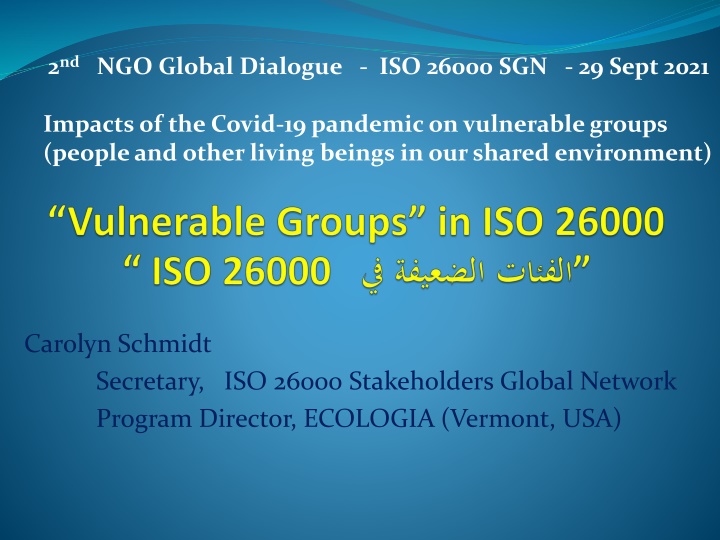
Impacts of Covid-19 Pandemic on Vulnerable Groups and Biodiversity Conservation
This presentation discusses the effects of the Covid-19 pandemic on vulnerable groups and the environment, emphasizing the importance of protecting human rights and biodiversity. It highlights the need for organizations to focus on the well-being and inclusion of marginalized communities while also prioritizing the preservation of natural habitats and species.
Download Presentation

Please find below an Image/Link to download the presentation.
The content on the website is provided AS IS for your information and personal use only. It may not be sold, licensed, or shared on other websites without obtaining consent from the author. If you encounter any issues during the download, it is possible that the publisher has removed the file from their server.
You are allowed to download the files provided on this website for personal or commercial use, subject to the condition that they are used lawfully. All files are the property of their respective owners.
The content on the website is provided AS IS for your information and personal use only. It may not be sold, licensed, or shared on other websites without obtaining consent from the author.
E N D
Presentation Transcript
2nd NGO Global Dialogue - ISO 26000 SGN - 29 Sept 2021 Impacts of the Covid-19 pandemic on vulnerable groups (people and other living beings in our shared environment) Carolyn Schmidt Secretary, ISO 26000 Stakeholders Global Network Program Director, ECOLOGIA (Vermont, USA)
HolisticIntegratedApproach Community Involvement and Development Human Rights l Consumer Issues Labour Practices Organizational Governance The Fair Environment Operating Practices Interdependence 2
Human Rights: Clause 6.3.7 Discrimination and vulnerable groups Groups that have suffered persistent discrimination, leading to entrenched disadvantages, are vulnerable to further discrimination, and their human rights should be the focus of additional attention in terms of protection and respect by organizations. Goal = full and effective participation in society of all groups, including those who are vulnerable 3
6.3.7.1; 6.3.7.2 Examples of vulnerable groups women and girls people with disabilities children indigenous peoples (note also collective rights to their traditional land) migrants, migrant workers, migrant families people discriminated against on the basis of descent, skin colour or culture (caste; race) elderly, displaced, poor, illiterate, people living with HIV/AIDS, minority and religious groups 4
Environment: Clause 6.5.6 Protection of the environment, biodiversity and restoration of natural habitats Value and protect biodiversity; aim to ensure the survival of terrestrial and aquatic species, genetic diversity and natural ecosystems Give highest priority to avoiding the loss of natural ecosystems, second to restoring ecosystems, and finally ..to compensating for losses through actions that will lead to a net gain in ecosystem services over time Take measures to preserve any endemic, threatened or endangered species or habitat that may be adversely affected 5
Some hard questions: How, exactly, do you go about protecting or advocating for these vulnerable groups vulnerable people, and vulnerable species, habitats and ecosystems ? Especially when much business as usual involves making money through exploiting vulnerable people (ex. low-wage workers) and vulnerable species (ex. habitat destruction by agricultural and extractive industries) ?? 6
5.3.2 Stakeholder identification Groups advocating social or environmental causes may be stakeholders of an organization whose decisions and activities have a relevant and significant impact on these causes ..In some cases, it will not be possible for important interests to be directly represented. For instance, children rarely own or control organized groups of people, wildlife cannot do so. In this situation, an organization should give attention to the views of credible groups seeking to protect such interests. 8
With this focus on stakeholders, ISO 26000 points to the role of NGOs / spokespeople for the vulnerable who do not have voices themselves - some global trends today: Build Back Better after Covid-19 Attempts to face and deal with inequalities revealed by Covid-19 and its harsh impact on the most vulnerable Rights of Nature Apply personhood rights - legal protections - to members of the natural world So, rivers, or endangered species, can go to court to protect themselves, or to sue for damages and restoration Ecuador, Bolivia, Canada, New Zealand, India, Bangladesh, Colombia, US . Improving public sector social safety nets (housing, health care, child care, minimum wage, public transportation, public utilities) 9
In conclusion. ISO 26000 provides global consensus guidance - pathways for: 1) identifying vulnerable groups people and our non- human relatives in our shared environment 2) NGOs and other spokespeople to speak and act in support of those vulnerable groups 3) calling on organizations with power, to act to protect vulnerable groups and to seek remedies for damages to them 4) gradually creating new international norms 10
Thank you very much (shukran jazilan) Carolyn Schmidt, Program Director, ECOLOGIA E-mail: cschmidt@ecologia.org Website: www.ecologia.org For more information on Rights of Nature: http://www.ecologia.org/ron 11
